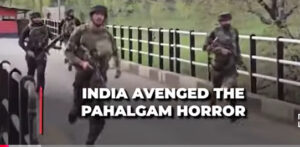*#Metronewz:New chapter has been added to my book “Operation Sindoor”Chapter 21* *Operation Mahadev* *#you_too_can_top* 14 Days, 1 Mission, Mahadev Peak: How the Pahalgam Mastermind Was Hunted Down
*#Metronewz:New chapter has been added to my book “Operation Sindoor”Chapter 21* *Operation Mahadev* *#you_too_can_top* 14 Days, 1 Mission, Mahadev Peak: How the Pahalgam Mastermind Was Hunted Down






 DAY 1 – Shadows over Mahadev
DAY 1 – Shadows over Mahadev
The silent forests beneath Mahadev Peak, towering over the scenic Dachigam valley, hid a dark secret. After the blood-soaked tragedy in Pahalgam, India’s elite counter-terrorism units vowed retaliation — not in haste but with precision. Deep in the wild, at 12,000 feet above sea level, surveillance teams intercepted encrypted Chinese military-grade communication signals — cold, coded, and deadly. The chatter was unmistakable: “WY-SMS”, the infamous communication protocol once used by Lashkar-e-Taiba in 2016, was back. Its origin? Somewhere in the icy wilderness of Mulnar, Harwan, at the base of Mahadev. The hunt had just begun.
DAY 3 – Phantom in the Trees
The intelligence was staggering — the mastermind of the Pahalgam attack was hiding here: Suleiman Shah, alias Hashim Musa, a ghost with a blood-soaked legacy. A former commando of Pakistan Army’s Special Services Group (SSG), Shah had vanished into Lashkar’s shadowy world years ago. Hardened in jungle warfare, survival, and insurgency tactics, he had become a myth until now. Using satellite imagery, ground reconnaissance, and direction-finding radars, the Indian Army and intelligence agencies triangulated the source of the encrypted signals. The needle pointed toward a camouflaged cluster of hideouts deep in the Mulnar jungles — possibly an operational base.
DAY 5 – The Steel Web Tightens
The Army’s elite 4 Para (Special Forces) were inserted into the periphery — silent, unseen, and in pairs. Meanwhile, technical intelligence confirmed multiple foreign fighters were in the area. The jungle was rigged — escape tunnels, booby traps, motion sensors. The teams would need patience and planning. The snow-fed streams nearby tv cold and fast — masking every footfall. The op was codenamed: Operation Mahadev — not only after the sacred peak, but also the divine destroyer in Indian mythology. Destruction of evil was imminent.
DAY 9 – A Clue in the Static
At 0400 hours, the SIGINT team intercepted a short-range encrypted message: “Move before full moon.” The implication was chilling: the terrorists were preparing for a high-profile attack, possibly on a civilian target in Srinagar during the Amarnath Yatra. The operation could no longer wait. The next 48 hours would be a race against time.
DAY 11 – Final Lock-On
Using drone surveillance with infrared vision, a brief movement was detected near an abandoned shepherd hut — a brief glint of metal in the undergrowth. It was confirmed: Shah, Afghan and Gibran all Category A++ targets, armed with carbines, AK-47s, and grenade launchers. The Army sealed off the escape routes. Infiltration teams were silently positioned along the ridges. The entire forest was now a pressure cooker, and the lid was about to blow.
DAY 13 – The Reckoning Begins
The One-Minute War That Lasted a Hundred Hours. It began not with a gunshot, but a whisper in the wind. Somewhere high in the undulating terrain between the Mahadev and Zabarvan ridges, deep behind the shadows of Dachigam National Park, came intel—scant, raw, but credible. A trio of heavily armed terrorists had slipped through the LoC and were believed to be regrouping in the thick alpine forests. Their mission was unknown. Their movements, erratic. But one thing was clear: they couldn’t be allowed to vanish into the mist.
Enter the 4 PARA (SF).
Twelve men. One Major. No air support. No second chances.
For over four days, these elite commandos became shadows in the forest—sleepless, silent, and calculating. The terrain was merciless. Temperatures dropped below zero at night, and the sun offered no kindness during the day. But not once did they complain or retreat. Their quarry? Three battle-hardened, Pakistan-trained infiltrators believed to be linked with Lashkar-e-Taiba. Heavily armed. Ruthless. Trained to kill and disappear. The search was a tactical ballet—slow, deliberate, and dangerously close to exposure. But the team held its nerve. Every rustle was noted. Every disturbed twig was logged. Still, the enemy eluded them. Until Day Four.
The Revelation: Micro Drones, Macro Impact
Just before dawn on the 100th hour, a nano drone the size of a palm lifted off silently from behind a boulder. Guided via thermal imaging and AI-assisted threat recognition, it skimmed past thick pine canopies and hovered near a makeshift camouflaged camp.
There they were. Sleeping. Clumped together like deadweight. Three terrorists. AK-47s next to them. One grenade belt. Two radio handsets. All weapons accounted for. None on alert. That one aerial snapshot changed the game. The drone sent encrypted live feed back to the command tablet in the hands of the Major leading the mission—a 29-year-old veteran of three earlier cross-border operations. His eyes scanned the visuals, and he whispered just two words into his throat mic:
“Initiate contact.”
The 4 Para team moved in like wraiths. Distance to target: 40 meters. Elevation: downhill gradient—perfect for a ballistic advantage. Night vision on. Safeties off.
At 03:46 AM, a single suppressed round cracked the silence. First terrorist down. Two startled shapes stirred. Another double-tap.Second down. Before the third could even reach for his weapon, the Major himself squeezed the trigger. The shot struck center-mass. Third down.
Total time: 58 seconds. Rounds fired: Six. Enemy retaliation: Zero.
Not a single soldier was injured. Not a single noise that could give away their position to any potential backup squads. It wasn’t a firefight. It was a clinical termination.
Aftermath
Weapons, radios, and recovered mobile phones revealed chats with handlers in Muzaffarabad and GPS coordinates linked to infiltration routes. The entire operation, though bloodless on the Indian side, thwarted a planned attack likely targeting Amarnath Yatra pilgrims. As dawn broke, the soldiers melted away into the forest, leaving behind no trace—except the still bodies of those who thought they could outwit India’s elite. Operation Mahadev wasn’t just a manhunt. It was a testament to India’s growing technological and tactical edge in high-altitude counter-insurgency. A story of patience, precision, and deadly silence.
The post-op sweep recovered:
3 AK-47s, 17 rifle grenades, Chinese-origin encrypted radios,Night vision scopes, High-calorie Pakistani combat rations, Map with planned routes into civilian zones,It was no ordinary cell — this was a mobile command unit, a snake’s head severed. Every item recovered had screamed “ I am from Pakistan “
Back in Pahalgam, tears turned into a quiet prayer. Justice had been delivered. Not with fanfare, but with the cold precision of a nation’s resolve. Operation Mahadev was more than just a tactical success. It was a message — that no matter how well-trained, how deep they hide, India’s enemies will be found, cornered, and neutralised. From the cruel silence of Pahalgam to the roaring mountains of Mahadev, this was a reckoning long in the making. And it had just begun.
The mountains and the Mahadev peak, for once, echoed not with gunfire but with the quiet pride of victory.







